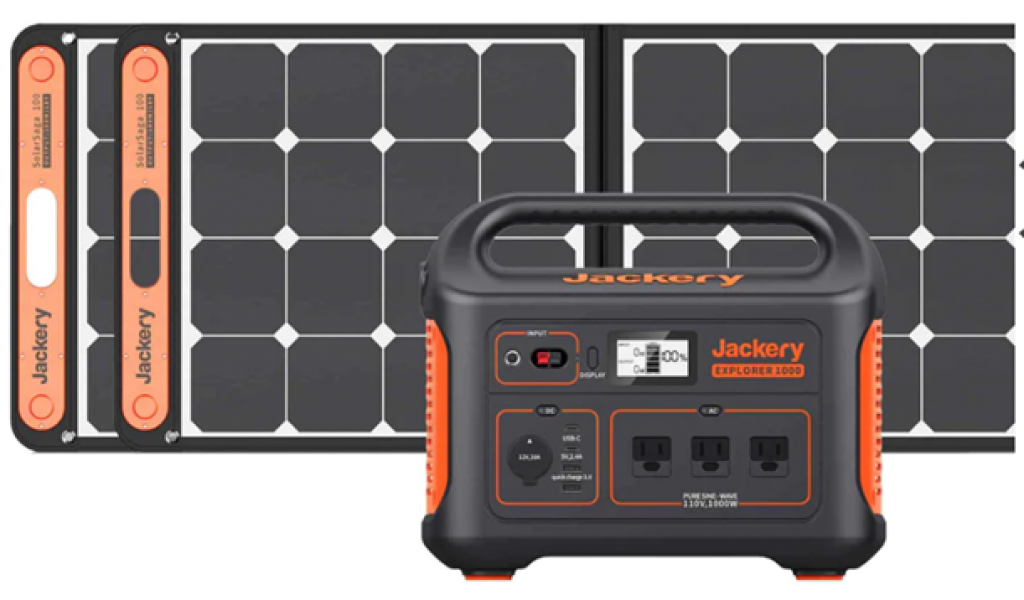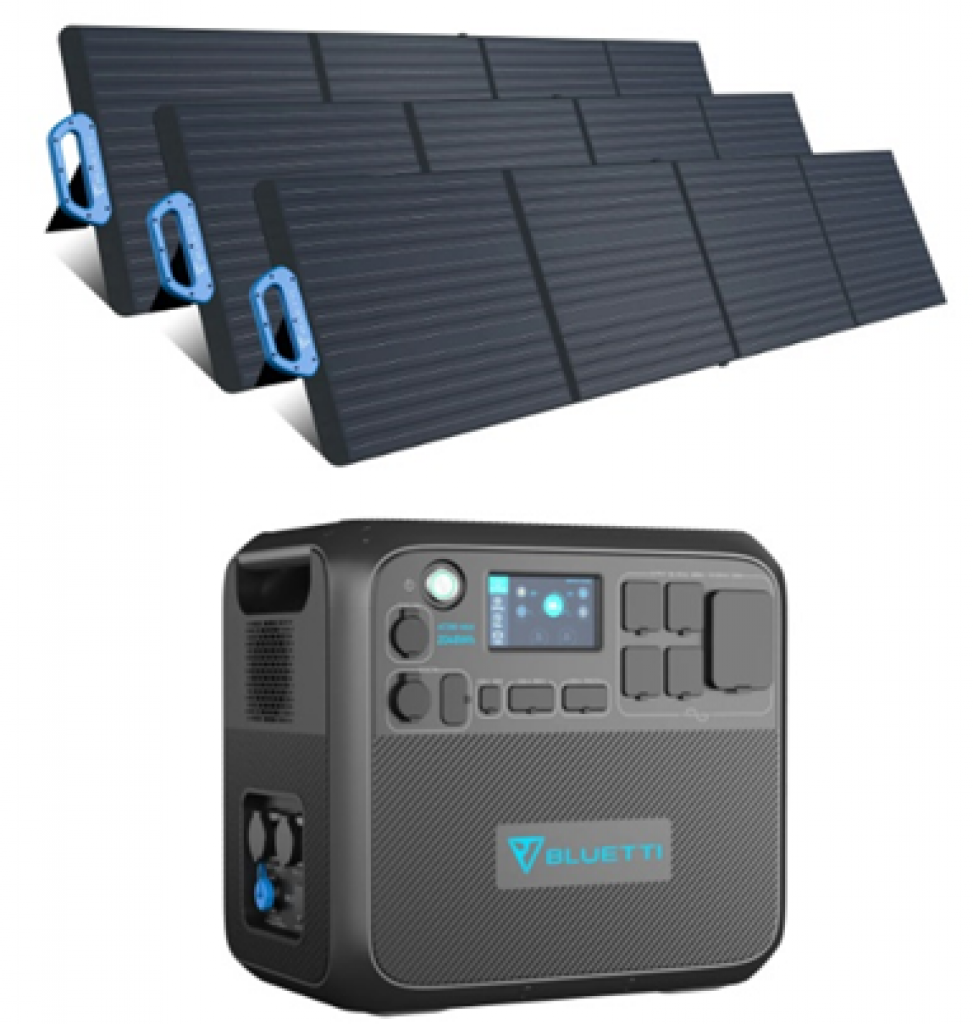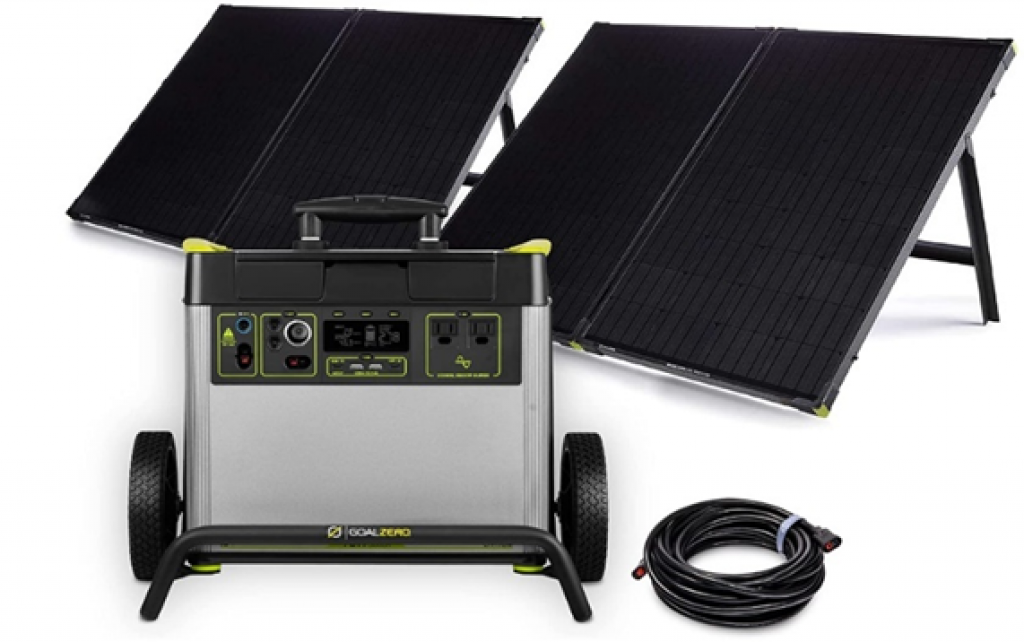It’s vital that you select the correct size solar generator to run a refrigerator during a power outage or camping trip.
Today, refrigerators are our most essential household appliances; they keep our food and beverages fresh for days.
There is a common misconception that refrigerators draw vast amounts of electricity and cannot be adequately powered using solar energy.
This article shows you how to size your solar generator to power a refrigerator, from the smallest unit suitable for a camping trip to the largest household one.
Lastly, we introduce the 3 best solar generators on the market equipped to run a refrigerator.
Table of Contents
How To Calculate What Size Solar Generator You Need
A solar generator is an all-in-one solution that combines the following:
The size of your solar generator is directly related to your electricity needs and your location’s solar irradiation (power of the sun).
We’ll show you how to size it properly in a four-step process.
Step 1. Determine Your Daily Energy Needs
There are two significant terms when referring to electricity: power and energy.
Power: expressed in Watt (W) or KiloWatt (kW = 1000W)
Energy: KiloWatt.hour (kWh = 1000Wh) in which 1kWh = 1kW x time of use in hours.
Nowadays, it’s easy to estimate your energy needs by listing all the appliances you’d like your solar generator to power.
For Example
| Appliances | Power (W) | Time of use /day (hour) | Energy (kWh) |
|---|---|---|---|
| 5 lights | 35W | 8 | 0.28 |
| TV | 100W | 5 | 0.5 |
| Electric Fan | 60W | 8 | 0.48 |
| Refrigerator | 80W | 24 | 0.7 |
| Laptop | 50W | 4 | 0.2 |
| Total | 325W | 2.16 |
Here, the daily energy consumption is 2.16kWh.
Let’s add 20% to this figure to compensate for system losses. Consequently, the daily production of the solar generator should be 2.6kWh.
Step 2. Calculate The Number Of Solar Panels For Your Solar Generator
Solar panels are essential components of your system — they convert sunlight into electricity used to recharge the built-in battery.
To determine your solar production in kWh/day, enter your location in the global solar atlas. In the result section, look at the “Specific Photovoltaic Power Output (PVOUT)” data in kWh/kWp.
For Los Angeles, California, this value is 4.98kWh/kWp. This means that, on average, 1kW (1000W) of solar panels (kWp, p is for peak) produces 4.98kWh per day.
Now let’s apply the simple formula below:

In our previous example, the daily demand is 2.6kWh.
If you’re located in California, your solar panels’ total power rating should be 522W or 2 solar panels of 270W.
Step 3. Determine The Correct Power Output For Your Solar Generator
If you’d like to connect multiple appliances simultaneously, you should check if the power output of your solar generator is sufficient.
In our example, the total power of the appliances is 325W, so we recommend a solar generator output of 1000W.
This figure is much larger than the total appliance’s power, so your inverter will not be overloaded when the refrigerator starts (refrigerators always draw a higher current when starting).
Step 4. Determine The Storage Capacity Of Your Solar Generator
Your solar generator’s built-in battery is your primary supplier of electricity.
The inverter will exclusively draw current from the battery to ensure a seamless power supply.
The capacity of a battery is rated in Wh or kWh. To make it through a rainy day, we recommend your battery capacity be at least equal to your daily needs.
In our example, a battery capacity of 2.6kWh is sufficient.
What Size Solar Generator Do I Need To Run A Refrigerator?
We’ll apply the four-step process described above to determine the correct size solar generator needed to power a refrigerator.
Daily Energy Consumption Of A Refrigerator
It’s time to determine your refrigerator’s daily energy consumption.
Contrary to popular belief, refrigerators are not running 24 hours a day. Instead, their compressor follows an On/Off cycle.
Therefore, you cannot multiply the rated power by 24 hours to get the daily energy consumption like with other appliances.
Instead, you will rely on the data provided by the Energy Star program, a US government-backed label, and energy certification.

Below we compiled the average energy consumption of different refrigerators (including their freezers) in the function of their volume (cubic-foot).
| Refrigerator size (cu.ft) | Average energy consumption per year (kWh) | Average energy consumption per day (kWh) |
|---|---|---|
| Less than 4 | 190 | 0.52 |
| 4 to 6.9 | 250 | 0.68 |
| 7 to14.9 | 300 | 0.82 |
| 15 to 17.9 | 450 | 1.23 |
| 18 to 23 | 550 | 1.5 |
| 23 and above | 650 | 1.78 |
Solar Generator Size Needed For Various Refrigerator Sizes
Let’s calculate the size of a solar generator needed to run a refrigerator, including solar panels, power output, and battery capacity.
We’ll consider the solar potential of California at 4.98kWh/kWp.
| Refrigerator size (cu.ft) | Total power solar panels (Wp) | Number of 100W solar panels | Battery capacity (kWh) | Power of the solar generator (W) |
|---|---|---|---|---|
| Less than 4 | 105 | 2 | 0.6 | 500 |
| 4 to 6.9 | 137 | 2 | 0.8 | 500 |
| 7 to14.9 | 165 | 2 | 1 | 500 |
| 15 to 17.9 | 247 | 3 | 1.5 | 500 |
| 18 to 23 | 301 | 4 | 1.8 | 1000 |
| 23 and above | 357 | 4 | 2.1 | 1000 |
Isn’t it impressive that only 2 solar panels of 100W and less than 1 kWh of battery are enough to run a domestic-size refrigerator with a freezer?
Now that you know how to size your solar generator for your refrigerator, let’s have a look at the three best solar generator products on the market:
3 Best Solar Generators To Run A Refrigerator
We researched the three best solar generators on the market to run a refrigerator, from the smallest unit for a camping trip or RV to the largest models to satisfy a family’s needs.
1. Jackery Solar Generator 1000 (Best For Mini Refrigerators)
The Jackery Solar Generator 1000 is the perfect bundle to power a small-size refrigerator (max. 4cu.ft) for any overlanding adventure.
It combines 2 solar panels of 100W each (Solarsaga 100) and a portable all-in-one power station with a capacity of 1kWh (Explorer 1000).
Jackery is one of the most trusted brands for solar generators, with high-quality products and state-of-the-art technology.
Connecting multiple solar panels to the generator is intuitive, and the built-in MPPT solar charger ensures fast charging (6.5 hours 0 to 80% charge).
Finally, the multiple outputs (4xUSB, 3xAC110V, DC car output) make it very convenient to power several devices simultaneously.
Solar Panel Specifications
| Power | 2*100W |
| Dimension | Unfolded: 48 x 21 x 0.2in (122 x 53.5 x 0.5cm) |
| Weight | 10.33 lbs (4.69 kg) |
Power Station Specifications
| Capacity | 1002Wh (1kWh) |
| Solar Charger | MPPT |
| Inverter | Pure Sine Wave – 1000W (2000W surge) |
| Outlets | 3*AC 110V, 4*USB, DC car output |
| Weight | 22lbs (10kg) |
| Dimension | 13.1 x 9.2 x 11.1in (33.3 x 23.3 x 28.3cm) |
| Warranty | 2 years |
2. Bluetti AC200MAX + 3*PV200 ( Best For Domestic Refrigerators)
The AC200 MAX from Bluetti is the ultimate power solution for a domestic-size refrigerator. It combines a 2kWh battery, a pure sine wave inverter, and the latest MPPT solar charger technology in a compact and modern design.
This is one of the most versatile solar generators, accepting 3 ways of charging (solar, carport, AC input), including fast charging up to 1,300W (full charge in 2 hours). With the 3 solar panels of the bundle, expect a full charge in 3.5 hours.
You’ll have the choice between 5 AC outlets (up to 2200W), 4 USB ports, 4x12V DC outlets, and two wireless charging pads to unleash its power.
Moreover, the battery offers more than 3,500 cycles (80% capacity) and comes with a 2-years warranty.
Solar Panel Specifications
| Power | 3*200W |
| Dimension | Unfolded: 23.2 x 89.2in (59 x 226cm) |
| Weight | 16.1 lbs (7.3kg) |
Power Station Specifications
| Capacity | 2048Wh (2kWh) |
| Solar Charger | MPPT |
| Inverter | Pure Sine Wave |
| Max. Power output | 2200W (4800W surge) |
| Outlets | 5*AC 110V, 4*USB, 4*DC, 2 wireless charging |
| Weight | 61.9lbs (28.1kg) |
| Dimension | 16.5 x 11 x 16.2in (42 x 28 x 38.6cm) |
| Warranty | 2 years |
3. Goal Zero Yeti 3000X (Best For Large Refrigerator)
You’ll need a solar generator with a large battery to power the biggest refrigerators. That’s precisely what the Goal Zero Yeti 3000x offers: 3kWh battery storage. With this generator, you’ll never run out of power and will even be able to supply electricity to other appliances.
This solar generator comes with 2 solar panels of 200W that will fully charge the solar battery in 8 hours.
The built-in pure sinewave inverter can power loads up to 2000W (3500W surge) through two 110V AC outlets, 4 USB, and 4 DC outlets.
Although the Goal Zero Yeti 3000X is a bit bulky (78 pounds), you can still move it with the convenient built-in wheels.
Solar Panel Specifications
| Power | 2*200W |
| Dimension | Unfolded: 40 x 53.5 x 1.75in (101 x 135 x 2.5cm) |
| Solar panel weight | 42lbs (19kg) |
Power Station Specifications
| Capacity | 3032Wh (3kWh) |
| Solar Charger | MPPT |
| Inverter | Pure Sine Wave |
| Max. Power output | 2000W (3000W surge) |
| Outlets | 2*AC 110V, 4*USB, 3*DC output |
| Weight | 78lbs (35.4kg) |
| Dimension | 25 x 19 x 23in (63.5 x 48 x 58.4cm) |
| Warranty | 1 year |
Final Thoughts
Americans have the biggest refrigerators in the world — on average, 17.5cu.ft.
But as big as they are, a solar generator would have no problem powering them.
You’ll need as little as 3 solar panels of 100W and a solar battery of 1.5kWh to run your average-sized refrigerator in California.
If you’re an outdoor enthusiast, this is the perfect time to get a portable solar generator.




